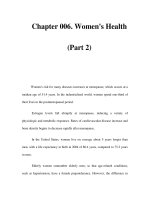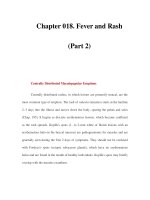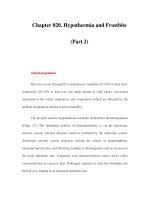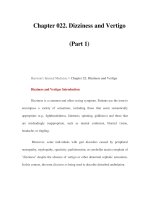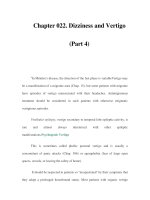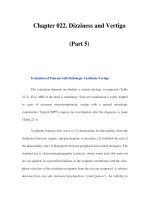Chapter 022. Dizziness and Vertigo (Part 2) pps
Bạn đang xem bản rút gọn của tài liệu. Xem và tải ngay bản đầy đủ của tài liệu tại đây (13.64 KB, 5 trang )
Chapter 022. Dizziness and Vertigo
(Part 2)
Physiologic Vertigo
This occurs in normal individuals when (1) the brain is confronted with an
intersensory mismatch among the three stabilizing sensory systems; (2) the
vestibular system is subjected to unfamiliar head movements to which it is
unadapted, such as in seasickness; (3) unusual head/neck positions, such as the
extreme extension when painting a ceiling; or (4) following a spin. Intersensory
mismatch explains carsickness, height vertigo, and the visual vertigo most
commonly experienced during motion picture chase scenes; in the latter, the visual
sensation of environmental movement is unaccompanied by concomitant
vestibular and somatosensory movement cues. Space sickness, a frequent transient
effect of active head movement in the weightless zero-gravity environment, is
another example of physiologic vertigo.
Pathologic Vertigo
This results from lesions of the visual, somatosensory, or vestibular
systems. Visual vertigo is caused by new or incorrect eyeglasses or by the sudden
onset of an extraocular muscle paresis with diplopia; in either instance, central
nervous system (CNS) compensation rapidly counteracts the vertigo.
Somatosensory vertigo, rare in isolation, is usually due to a peripheral neuropathy
or myelopathy that reduces the sensory input necessary for central compensation
when there is dysfunction of the vestibular or visual systems.
The most common cause of pathologic vertigo is vestibular dysfunction
involving either its end organ (labyrinth), nerve, or central connections. The
vertigo is associated with jerk nystagmus and is frequently accompanied by
nausea, postural unsteadiness, and gait ataxia. Since vertigo increases with rapid
head movements, patients tend to hold their heads still.
Labyrinthine Dysfunction
This causes severe rotational or linear vertigo. When rotational, the
hallucination of movement, whether of environment or self, is directed away from
the side of the lesion. The fast phases of nystagmus beat away from the lesion
side, and the tendency to fall is toward the side of the lesion, particularly in
darkness or with the eyes closed.
Under normal circumstances, when the head is straight and immobile, the
vestibular end organs generate a tonic resting firing frequency that is equal from
the two sides. With any rotational acceleration, the anatomic positions of the
semicircular canals on each side necessitate an increased firing rate from one and a
commensurate decrease from the other. This change in neural activity is ultimately
projected to the cerebral cortex, where it is summed with inputs from the visual
and somatosensory systems to produce the appropriate conscious sense of
rotational movement. After cessation of prolonged rotation, the firing frequencies
of the two end organs reverse; the side with the initially increased rate decreases,
and the other side increases. A sense of rotation in the opposite direction is
experienced; since there is no actual head movement, this hallucinatory sensation
is physiologic postrotational vertigo.
Any disease state that changes the firing frequency of an end organ,
producing unequal neural input to the brainstem and ultimately the cerebral cortex,
causes vertigo. The symptom can be conceptualized as the cortex inappropriately
interpreting the abnormal neural input as indicating actual head rotation. Transient
abnormalities produce short-lived symptoms. With a fixed unilateral deficit,
central compensatory mechanisms ultimately diminish the vertigo. Since
compensation depends on the plasticity of connections between the vestibular
nuclei and the cerebellum, patients with brainstem or cerebellar disease have
diminished adaptive capacity, and symptoms may persist indefinitely.
Compensation is always inadequate for severe fixed bilateral lesions despite
normal cerebellar connections; these patients are permanently symptomatic when
they move their heads.
Acute unilateral labyrinthine dysfunction is caused by infection, trauma,
and ischemia. Often, no specific etiology is uncovered, and the nonspecific terms
acute labyrinthitis, acute peripheral vestibulopathy, or vestibular neuritis are used
to describe the event. The vertiginous attacks are brief and leave the patient with
mild vertigo for several days. Infection with herpes simplex virus type 1 has been
implicated. It is impossible to predict whether a patient recovering from the first
bout of vertigo will have recurrent episodes.
Labyrinthine ischemia, presumably due to occlusion of the labyrinthine
branch of the internal auditory artery, may be the sole manifestation of
vertebrobasilar insufficiency (Chap. 364); patients with this syndrome present with
the abrupt onset of severe vertigo, nausea, and vomiting, but without tinnitus or
hearing loss.
Acute bilateral labyrinthine dysfunction is usually the result of toxins such
as drugs or alcohol. The most common offending drugs are the aminoglycoside
antibiotics that damage the hair cells of the vestibular end organs and may cause a
permanent disorder of equilibrium.
